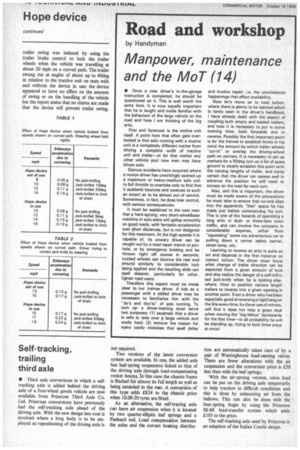Road and workshop
Page 48

If you've noticed an error in this article please click here to report it so we can fix it.
by Handyman
Manpower, maintenance and the MoT (14)
• Once a new driver's in-the-garage instruction is completed, he should be questioned on it. This is well worth the extra time. It is now equally important that he is taught and made familiar with the behaviour of the large vehicle on the road and here I am thinking of the big artic.
First and foremost is the motive unit itself. A point here that often gets overlooked is that solo running with a motive unit is a completely different matter from driving a complete outfit of tractive unit and trailer—or for that matter any other vehicle your new man may have driven solo.
Serious accidents have occurred where a novice driver has unwittingly opened up a maximum or heavy-medium solo unit to full throttle to overtake only to find that it suddenly bounces and swerves to such an extent as to be almost out of control. Sometimes, in fact, he does lose control, with serious consequencies.
It must be explained to the new man that a hard-sprung, very short-wheelbase machine in solo state will gallop smoothly on good roads, with fantastic acceleration over short distances, but is not designed for this treatment. At the high speeds it is capable of, its unwary driver can be caught out by a road repair trench or pothole, or by emergency braking and be thrown right off course in seconds. Locked wheels can bounce the rear end around similarly to considerable lock being applied and the resulting slide can spell disaster, particularly for other, lighter road users.
Therefore this aspect must be made clear to our trainee driver. A ride as a passenger with a skilled driver may be necessary to familiarize him with the -do's and don'ts" of solo running. To sum up: a driver-training must serve two purposes: (1) ascertain that a driver is safe to take over a large vehicle and costly load; (2) remove the reason for many costly mistakes that spell delay'
and involve repair, i.e. the unscheduled happenings that affect availability.
Now let's move on to road tuition, where there is plenty to be learned which is rarely seen in the driver's handbook. I have already dealt with the aspect of coupling both empty and loaded trailers, and now it is necessary to put in some running time, both forwards and in reverse. Possibly the first important point is for the trainee to establish firmly in his mind the amount by which trailer wheels "cut-in" or overlap the driving-wheel path on corners. It is necessary to set up markers for a 90deg turn on a bit of spare ground to clearly establish this point with the varying lengths of trailer, and ma ke certain that the driver can assess well in advance the position he will need to occupy on the road for each turn.
Also, and this is important, the driver must be made aware of the precautions he must take to ensure that no-one slips into the apparently "free" space he has made just before commencing his turn. This is one of the hazards of operating a long artic in dualor three-lane town traffic, and can involve the company in considerable expense, either from "squeezing" some too adventurous car or pulling down a corner safety barrier, street lamp, etc.
Learning to reverse an artic is quite an art and depends in the first instance on correct tuition. The driver must know what change of trailer direction can be expected from a given amount of lock and also realize the danger of a self-inflicted jack-knife when he is looking elsewhere. How to position various length trailers to reverse into a given opening is another point. Even a driver who has been especially good at reversing a rigid bang on the line every time, by clever use of mirrors, will find it does not help a great deal when moving the "big fellow" backwards for the first time—in all probability he will be standing up, trying to look three ways at once!
























































































































